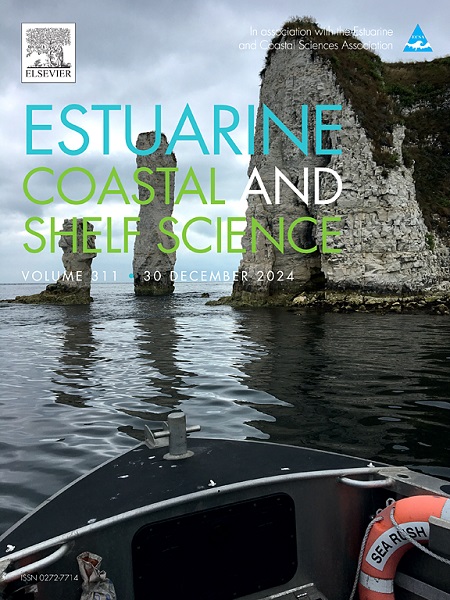一个集约利用的温带海洋港湾的生态网络分析与生态指标
IF 2.6
3区 地球科学
Q1 MARINE & FRESHWATER BIOLOGY
引用次数: 0
摘要
考克伯恩湾是西澳大利亚使用最密集的海洋区域之一,有着主要工业发展和营养物污染的历史。这导致了20世纪50年代至21世纪初海草草地的大量损失(约80%),以及被捕捞鱼类的减少,如粉红鲷鱼(Chrysophrys auratus)和蓝游泳蟹(Portunus armatus)。然而,科伯恩湾因其生态、经济和娱乐属性而受到社区的高度重视。在这项研究中,我们利用Ecopath和Ecosim软件开发了一个定量的生态系统模型,以确定生态系统性能的生态指标,并阐明系统的功能,包括:(1)食物网中的生物量流动;(2)重点物种鉴定;(3)生态网络的界定。我们根据2021-22年主要研究项目的当地生物调查和专家咨询确定了73个官能团。该模型确定了关键群体的生态作用,这些群体被定义为通过与捕食(自上而下的力量)相关的过程构建物种,其中鲨鱼、宽吻海豚(Tursiops truncates)、澳大利亚海狮(Neophoca cinerea)和鸬鹚(Phalocrocorax spp.)是系统中功能重要的物种。混合营养影响(MTI)分析结果表明,商业渔业和休闲渔业对鱼类生物量的影响不大,但鱿鱼跳跳渔业与海豚之间通过共享食物资源(鱿鱼)存在间接影响。本研究中产生的生态指标提供了有关科伯恩湾生态系统营养结构、能量学和功能的基线信息,可用于告知管理人员该系统如何应对压力和干扰(如基础设施发展和气候变化),并用于评估替代管理策略。Ecopath模型强调了科伯恩湾生态的复杂性,显示了这个食物网中高级和低级营养群体的作用。这一点尤其重要,因为了解系统内的过程和相互作用可以支持保护和管理计划。本文章由计算机程序翻译,如有差异,请以英文原文为准。

Ecological network analysis and ecological indicators for an intensively used temperate marine embayment
Cockburn Sound is one of the most intensively used marine areas in Western Australia and has a history of major industrial development and nutrient pollution. This has contributed to significant losses of seagrass meadows (∼80 %) between the 1950s and early 2000s and declines in exploited fish species such as pink snapper (Chrysophrys auratus) and blue swimmer crab (Portunus armatus). However, Cockburn Sound remains highly valued by the community for its ecological, economic, and recreational attributes. In this study, we developed a quantitative ecosystem model using Ecopath with Ecosim software to identify ecological indicators for ecosystem performance and elucidate how the system functions, including: (1) biomass flow in the food web; (2) identifying keystone species; and (3) defining the ecological network. We defined 73 functional groups based on both local biological surveys from a major research program in 2021–22 and expert consultation. The model identified the ecological role of keystone groups defined as structuring species by processes associated with predation (top-down forces) with sharks, bottlenose dolphin (Tursiops truncates), Australian sea lion (Neophoca cinerea), and cormorants (Phalocrocorax spp.) as functionally important species in the system. The results from the mixed trophic impact (MTI) analysis indicated that commercial and recreational fisheries did not have a major impact on the biomass of fished species, but some indirect impacts were found between the squid jigging fishery and dolphins through shared food resources (squid). The ecological indicators generated in this study provide baseline information on the trophic structure, energetics, and function of the Cockburn Sound ecosystem, and can be used to inform managers on how the system may respond to stressors and disturbances e.g., infrastructure development and climate change, and be used in evaluating alternative management strategies. The Ecopath model highlighted the complexity of Cockburn Sound's ecology, showing the role of higher and lower trophic groups in this food web. This is particularly important because understanding the processes and interactions within the system can support plans for conservation and management.
求助全文
通过发布文献求助,成功后即可免费获取论文全文。
去求助
来源期刊
CiteScore
5.60
自引率
7.10%
发文量
374
审稿时长
9 months
期刊介绍:
Estuarine, Coastal and Shelf Science is an international multidisciplinary journal devoted to the analysis of saline water phenomena ranging from the outer edge of the continental shelf to the upper limits of the tidal zone. The journal provides a unique forum, unifying the multidisciplinary approaches to the study of the oceanography of estuaries, coastal zones, and continental shelf seas. It features original research papers, review papers and short communications treating such disciplines as zoology, botany, geology, sedimentology, physical oceanography.

 求助内容:
求助内容: 应助结果提醒方式:
应助结果提醒方式:


